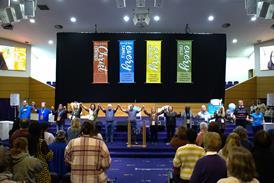It can be easy to be always on the lookout for the next big thing in youth ministry, so we can get on board and be relevant and up to date and on trend. Our regular contributor and youth-work expert, Mark Oestreicher, takes us through his thinking about the future trend of youth ministry, and it’s not what you might think.

I see the kingdom of God in less black-and-white frames these days. To say it’s a full grayscale doesn’t even do it justice. The kingdom of God deserves a colour palette so broad, deep and rich that we don’t have names for all the nuance and variation.
I try to resist, also, the urge I still possess to reduce dialogue to discussion. The latter has its Latin roots in ‘to smash apart’ and ‘to scatter or disperse’ and shares some etymology with percussion. The former implies two-way (or three-way or more) conversation, give and take, listening.
All that said, I’m still intrigued by opposites. Lately, I’m rediscovering how some apparent opposites are actually two sides of the same coin. It’s pretty difficult to separate the two sides of a coin. I suppose, with great machining skill, one could slice a coin down the middle, but it would cease being a coin. Suffering and hope are that way, I’m learning. And I learned over the last few years how letting go of security and gaining wisdom fall into this truth-pattern.
But sometimes things that appear to be opposites are…well…really and truly opposites. And a move to the opposite is what’s called for in the world of youth ministry these days: a move from being driven to being present.

Makin’ copies
I’m an American, and we love to think of our ourselves as wildly independent. One doesn’t have to travel the world much to discover this uniqueness. To take it a step further, we actually like this about ourselves (and dear reader: don’t wrongly assume that because you’re not American that you can ignore this for your own context). It’s part of our country’s founding principle: we will be independent from you and no one can tell us who to be.
In the Church, we want so desperately to be independent mavericks, a Christianised version of the Marlboro Man, riding through the landscape of culture, needing no one, emulating no one. But if we look carefully at the churches we’ve lauded in the last 40 years or so, we’re really not all that original. Most of the time we are acquiescers, copiers. We copy culture and convince ourselves we birthed it.
Really, what’s independent, maverick-y and unique (or even interesting, for that matter) about building a cool youth space these days, complete with comfy (used) seating and snazzy art on the walls? Take a slow browse through a youth worker Facebook group these days, and you’ll regularly see youth workers asking for input on their meeting space and how to make it more attractive. Nothin’ original ’bout that, pardner.
We love to copy each other. And, in our rarest moments of honesty, we might be able to admit that we love, love, love being copied. Being copied is, after all, about the highest form of flattery a church or professional Christian can experience, right? But while we might all be copying each other these days (or whatever the church-du-jour is serving up), we’re ultimately copying the values of the culture around us. And those values, for the past five decades or so, have rested on variations of being driven.
Decades of driven
Remember the 80s movie Wall Street, starring a young Michael Douglas and a younger Charlie Sheen? That film didn’t only depict the excess (or risk) of materialism and greed. It was a great / horrible snapshot of being driven.
One of the most classic lines of the film occurs when Charlie Sheen’s character, a wannabe financial player named Bud Fox, asks Michael Douglas’s Gordon Gekko if he would be willing to have lunch. Gekko responds: “Lunch is for wimps.” In other words, I am more successful in life than you because I am 110 percent completely consumed – driven – by this singular passion (in this case, making deals).
That, my youth worker friends, has been the spirit of the age for the last handful of decades. Sure, we put a nice spiritual glaze on it when we copied it into the Church. After all, we value being driven for the glory of God!
Just look at our superstars: they are mostly (with a handful of wonderful exceptions) hyper-driven, type-A, overachievers who leave us all gasping and self-flagellating, wondering how they accomplish so darn much. We respect their driven-ness. We covet their driven-ness. Sometimes, we even worship their driven-ness.
O, that youth ministry had sashayed past this. But we didn’t. I didn’t.

Driven-ness in youth ministry
My suggestion, in a book I wrote about 15 years ago, was that youth ministry was “proclamation-driven” from roughly post-World War Two (when the modern era of youth culture and youth ministry stepped onto the scene) until the late 60s and early 70s.
Youth workers, responding to a call from God to contextualise the gospel for teenagers in their world, were missionaries by impulse. They were passionate – driven – by the idea that the spoken word, when wrapped in youth-friendly language and topics, would bring change.
I’m not questioning the (potential) power of preaching. Nor am I, for a second, questioning the motives of those early youth workers. It was the culturally appropriate youth ministry approach for its time (whether it was biblically and theologically informed or not).
As the Church woke up to the need for effective youth ministry, approaches pioneered by these proclamation-driven first wave youth evangelists were coopted and modified. A massive shift took place, though few saw it at the time.
The shift, in a nutshell, was a move from “we’ll bring the gospel to you” to “come to us and get the gospel”. That might not seem overly significant, but it ushered in a host of other tweaks and truncations. One of the primary shifts was in ‘the driver’. Proclamation was no longer the main focus and youth ministry in the church became programme driven.
There are lots of good and not-so-good reasons for this, and we don’t have time or space to go into detail here. But I’m convinced most youth ministry continues down this path to this day. It’s not that programmes are bad, per se. But a focus on programmes – programmes as the driver – is lopsided at best, and completely unbiblical at worst.
Again, I’m not questioning the motivation of youth workers. I’m questioning the assumption, the driver. The seduction of this approach was that it worked…for a while. It worked for a few decades.
But times have changed, and youth culture has changed, and teenagers have changed (in some ways). The ‘if you build it, they will come’, Field of Dreams approach just isn’t attractional enough anymore (my British youth ministry friends may have realised this prior to my American youth ministry friends).
An alternative: presence
When I was writing that book, Youth Ministry 3.0, I was creating a grid with a half-dozen variables to show the comparative shifts from 1.0 to 2.0, and to suggest 3.0. I knew, early on, that one of the variables I wanted to address was this issue of the driver. And I had the wording for ‘proclamation-driven’ and ‘programme-driven’ fairly early on.
But months into the process of fleshing out my thinking, I still couldn’t discern what the driver should be for this new epoch. I considered ‘mission’ for a while, but landed on that as one of the key values (a different variable on my grid).
I considered ‘community’ or ‘communion’ for a while, but also ended up adding that as a key value. Whatever words or concepts or vibes I had floating around in my pea-brain were not translating into verbiage.
So I asked for help. I put the question out on my blog, to the community of youth workers. I think that particular blog post resulted in amazing dialogue – not discussion – that was rich and varied. Most of the comments suggested an alternative driver; none of them resonated with me. But a few people questioned the very paradigm.
And that’s when it struck me:
If a driver was ever culturally appropriate…
If a driver was ever biblical…
At the very least…
Being ‘driven’ no longer fits.
And, to show my hand a bit more, I have become more and more convinced that being driven was always a mere cultural adaptation – copying – and not a worthwhile biblical construct.
So: if we’re not driven by something, then what? And that’s when ‘present’ struck me. You might even say that it was in the very act of being present to this question that the notion of presence revealed its weightiness.
Presence is the opposite of driven-ness (and not the other side of the coin). I’m becoming convinced that I cannot be simultaneously driven and present. I can be one or the other, but not both, not at the same time.
Some might say: “Wait a minute there, Mr Semantics! Jesus was driven! In fact, Jesus did his fair share of ‘driving’!” Well, let’s look at that for a moment:
- Jesus drove out evil spirits (Matthew 8:16; Mark 1:34 among others).
- Jesus drove the money changers out of the temple (Matthew 21:12-13; John 2:13-17).
Seems like the only examples we have of Jesus and ‘driving’ is when he was driving something bad out, not when he was himself being driven by anything other than love.
So why not say we should be driven by love? Maybe I’m just playing with words here (I don’t think I am, but I’m open to being wrong). But I believe that the primary action of love is to be present, not to drive or push. Instead of saying we should be driven by love, it seems more accurate (and biblical) to say love compels us to be present.

What is presence?
Let me unpack this a bit with an example from my own life. My young adult son, Max, is one of the true joys of my life. He’s an amazing young man. He’s sensitive and empathic and gentle, full of creativity and humor. But Max used to regularly drive us nuts in his apparent inability to focus beyond the moment. He forgets what we have asked him to do (but is genuinely sad and sorry about it); he loses things – valuable things – all the time. He’s easily distracted.
This behaviour is a challenge for Max’s teachers also. I remember a couple years ago, when his teacher – a tender-hearted saint of a woman and a highly gifted teacher – reconfigured my entire view of Max’s apparent lack of care for whatever goal seems pressing to all but him. She and I were sharing, in passing, about some deadline he’d missed or item he’d misplaced, and she uttered this simple little insight into living: “Well, we all have something to learn from Max about being present in every moment.”
Bam. That was it. Max, the awesome kid that he is, isn’t driven. And while this may be occasionally frustrating to a naturally driven guy like me, and might sometimes cause speed bumps in Max’s journey (speed bumps are there for a purpose, by the way: to slow us down!), he possesses a Jesus-y skill that I am so very far from attaining.
Presence is all about living in the moment, soaking it in, in all its glory. Presence listens and watches. Presence honors others by focusing on them (rather than a to-do list or the person over their shoulder that you’d rather talk to). Presence waits for the Spirit, rather than rushing toward one’s own goals. Presence relishes and snuggles and pays attention. Presence forfeits and postpones and stays.
And that, my friends, is what youth ministry is supposed to be about. At least, that’s what good youth ministry is about.
Let’s look at one more story from the life of Jesus. It’s one you’re very familiar with, and have likely taught on. It’s the story of Martha and Mary.
Luke 10:38-42 says:
As Jesus and his disciples were on their way, he came to a village where a woman named Martha opened her home to him. She had a sister called Mary, who sat at the Lord’s feet listening to what he said. But Martha was distracted by all the preparations that had to be made. She came to him and asked, “Lord, don’t you care that my sister has left me to do the work by myself? Tell her to help me!”
“Martha, Martha,” the Lord answered, “you are worried and upset about many things, but only one thing is needed. Mary has chosen what is better, and it will not be taken away from her.”
There’s a focused point here: being present to Jesus is better than focusing on the stuff that needs to get done. But there’s a broader way of living that Jesus is promoting, which he models with his life, as we see it in scripture: being present is a better way to live! Being present is what we were designed for.
The enemies of presence
In our driven youth ministry lives, there are many enemies of presence. But let’s quickly look at three of them.
Goal obsession
Goals have their place. For instance, if I didn’t ever have goals, I would stand no chance of getting my immense to-do list completed. But our churches and, as a result, our youth ministries, have become goal obsessed. This obsession is more of a reflection of the process of strategic planning being imported into the Church than it is a reflection of biblical values.
I heard an uncommon pastor refer to this once. He said that most of us have a ‘destination’ view of life instead of a ‘journey’ view of life. If all we focus on is the destination, we stand to completely miss out on the joy and blessing of the journey. But if we live with the journey, all we need think about is the next step, our next move toward Jesus, our next opportunity to embody and embrace love.
Inflexibility
An unfortunate cousin to goal obsession is inflexibility. I regularly miss out on being present to others, present to Jesus, and present to the Spirit’s nudging in my life because of my natural inflexibility. When I have a plan in place, it always feels like a significant and unacceptable compromise to readjust and redirect.
Jesus was the master of flexibility. Watch him on the extremely important and politically valuable way to heal the daughter of an important government official, when he stops to have a life-altering conversation with the bleeding woman (Luke 8:42b-48, as well as accounts in Matthew and Mark).
Check him out when he stops teaching to address the faith of the dudes who lowered their friend through a hole in the roof on a mat (Luke 5:17-26, as well as an account in Mark). Over and over again, Jesus pushes the pause button and leans into flexibility, in order to be present.
Confidence
Confidence is a good thing, right? Sure, when our confidence is in Christ. But confidence can easily turn on us and devour presence. When I’m sure I’m right, and you’re wrong, I forfeit the opportunity to be present. When I tighten the grip of my plan, my knowledge, my whatever, I rip myself off; and I walk right past – charge on past, really – any hope of seeing God in another, or sensing the presence of God, or hearing the still small, re-directing voice of God.
Why presence matters in youth ministry
No need to draw this out, as I’m sure by now, this is very clear to you. Our calling is not about programmes. Our calling is about people – particularly teenagers. And teenagers, being created in the image of God, are wired for belonging.
Here me on this: teenagers do not experience belonging because of our wonderful programmes, they experience belonging when someone is present to them. Then, they get an appetiser for the belonging they can experience through the presence of Christ. And, ultimately, isn’t that what we long for? Isn’t that what our calling is all about?











































